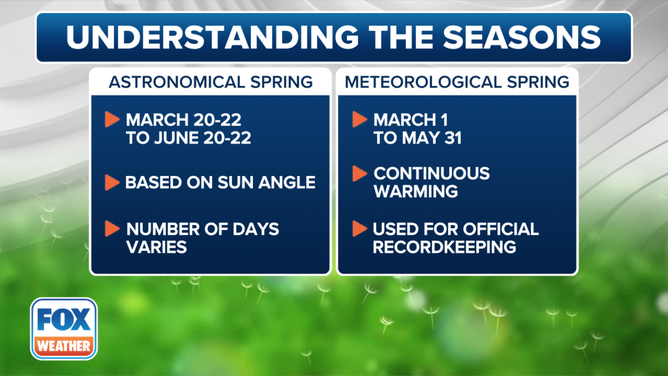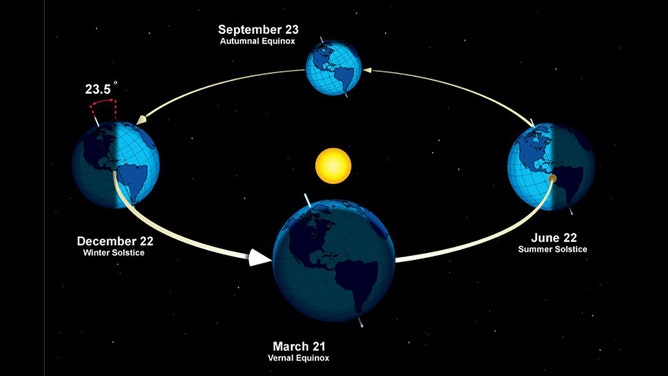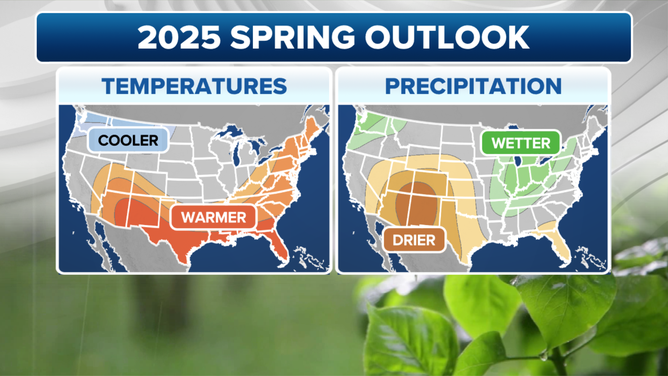First day of spring is March 20: Here's the science behind the vernal equinox
In 2025, the vernal equinox occurs March 20 at 5:01 a.m. EDT, marking the official start of spring in the Northern Hemisphere. Here's how astronomers come up with that precise time.
What is the vernal equinox? The science behind the astronomical seasons explained
The vernal equinox marks the beginning of astronomical spring and occurs in the Northern Hemisphere around March 20th, whereas the autumnal equinox falls around September 22nd.
Spring officially begins in the Northern Hemisphere on March 20 with the vernal equinox as the entire world experiences an equal amount of daylight and darkness.
For ease of recordkeeping, meteorologists and climatologists consider March 1 the first day of spring. Astronomically speaking, however, the Earth’s equator is aligned directly with the Sun on the vernal equinox. In 2025, that occurs at 5:01 a.m. EDT on March 20.
Astronomical seasons are based on the Earth's position with respect to the Sun, as the planet makes its annual revolution around our star.
TIME-LAPSE SHOWS SUN ANGLE CHANGE FOR THE START OF SPRING

The start of spring depends on whether you're referring to the astronomical or the meteorological start.
(FOX Weather)
The Earth is tilted approximately 23.5 degrees off a vertical axis, and because of this tilt, the most direct sunlight is aimed at the Southern Hemisphere during our astronomical winter and at the Northern Hemisphere during our astronomical summer.
The two solstices and two equinoxes are simply precise moments in time when the Sun is in direct alignment with three distinct bands of latitude.
DOWNLOAD THE FREE FOX WEATHER APP

The Earth's orbit around the Sun gives our planet its four seasons.
(National Weather Service)
Their dates can vary by a day or two each year since it takes the Earth 365 days and 6 hours (365.25 days) to make one full revolution around the Sun, which is why we have a leap year every four years.
On the winter solstice in December, the Sun's most direct rays are positioned over the Tropic of Capricorn (23.5 degrees south latitude). On June's summer solstice, the most direct rays of sunlight are in alignment with the Tropic of Cancer (23.5 degrees north latitude).
On the vernal equinox in March and the autumnal equinox in September, the equator (0 degrees latitude) is aligned directly with the Sun. Therefore, everywhere on Earth experiences an equal 12 hours of daylight and darkness because the Sun rises due east and sets due west.
LA NINA IS FADING, BRINGING SPRING TEMPERATURE SPLIT WITH VARYING RAIN PATTERNS: NOAA

A look at the temperature and precipitation outlooks for meteorological spring this year.
(FOX Weather)
In the summer, the Sun rises in the northeastern sky and sets in the northwestern sky, providing long days and short nights. The Sun reaches its highest and northernmost point in the sky at solar noon (around 1 p.m. local time due to daylight saving time) on the summer solstice. This provides the most direct solar radiation of the year, resulting in more heating of the Earth’s surface and, therefore, warmer temperatures.
In the winter, the sunrise is in the southeastern sky and the sunset is in the southwestern sky – a much shorter path across the Northern Hemisphere sky – so days are short and nights are long. The solar-noon Sun angle is the lowest and farthest south in the sky on the winter solstice. This means we have the least direct solar radiation of the year on the first day of winter, resulting in colder temperatures because there’s less heating of the Earth’s surface.
WHY DON'T THE EARLIEST SUNSETS AND LATEST SUNRISES COINCIDE WITH THE WINTER SOLSTICE?
Interestingly, Earth’s orbit around the Sun is elliptical (not perfectly circular), so our planet is actually closest to the Sun in January (perihelion) during the Northern Hemisphere winter and farthest from the Sun in July (aphelion) during the Northern Hemisphere summer.
